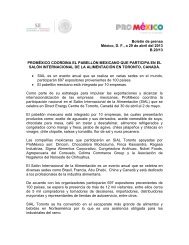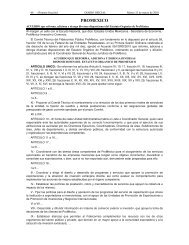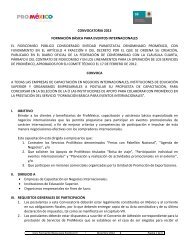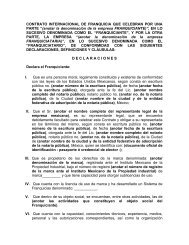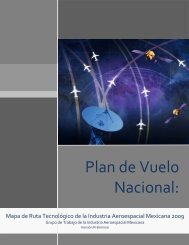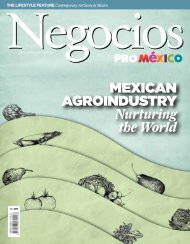AUTOMOTIVE IndUsTrY In MExIcO Ready to Overtake - ProMéxico
AUTOMOTIVE IndUsTrY In MExIcO Ready to Overtake - ProMéxico
AUTOMOTIVE IndUsTrY In MExIcO Ready to Overtake - ProMéxico
Create successful ePaper yourself
Turn your PDF publications into a flip-book with our unique Google optimized e-Paper software.
70 Negocios <strong>ProMéxico</strong> | The Lifestyle Negocios <strong>ProMéxico</strong> | The Lifestyle 71<br />
Zacahuil<br />
tHe tAmAle<br />
oF tAmAles<br />
Every Saturday and Sunday morning, people<br />
flock <strong>to</strong> the markets and squares of Mexico’s<br />
Huasteca region for their weekly zacahuil fix.<br />
A tamale in a class of its own, the zacahuil has<br />
ancient ritualistic connotations. Also known<br />
as the party tamale, this giant can measure as<br />
much as two meters long, feed over 50 people<br />
and take up <strong>to</strong> 12 hours <strong>to</strong> cook.<br />
____<br />
by cristina ávila-zesatti<br />
pho<strong>to</strong>s archive<br />
When Petronila Hernández Rivas cut the Rosca de<br />
Reyes on January 6 she wasn’t just celebrating<br />
Epiphany. The day before, she had turned 71 –in<br />
good health and still cooking away.<br />
“How long have I been doing this? Let me think… More than 45<br />
years and counting. This is my life, this is what I know how <strong>to</strong> do,<br />
what I love doing most,” she says.<br />
Doña Petra, as she is known in her native Pánuco, Veracruz, has<br />
devoted more than half her life <strong>to</strong> making and selling zacahuil, a<br />
type of giant tamale that is made and eaten throughout Mexico’s<br />
Huasteca region. Variations of this regional specialty can be found<br />
all along the Sierra Madre Oriental, in the states of Hidalgo, Veracruz,<br />
San Luis Po<strong>to</strong>sí, Tamaulipas, Puebla and Querétaro.<br />
On Saturdays and Sundays, Doña Petra sells her zacahuil at the<br />
Juárez market. Her market stall was one of the first in Pánuco and<br />
she now advertises on the <strong>In</strong>ternet, with the help of her children.<br />
She is one of many women who have rescued ancient culinary traditions<br />
and kept them alive, for the zacahuil is indubitably among<br />
the most ancient Pre-Columbian dishes in all of Mexico, not <strong>to</strong><br />
mention one of the most complex and surprising.<br />
more than grand, it is grandiose<br />
Made of ground corn, dried chili peppers and chicken or pork, this is<br />
not your average tamale. The zacahuil can measure as much as two<br />
meters long, one meter tall and 60 centimeters wide, and is cooked<br />
for between 10 and 12 hours in a special clay and wood oven.<br />
But it’s not just its size, the way it’s made and its ingredients that<br />
make the zacahuil so special. <strong>In</strong> the words of Amaranta Castillo<br />
Gómez, an anthropologist and academic at the Au<strong>to</strong>nomous University<br />
of Tamaulipas (UAT) who has spent 11 years researching –and<br />
continues <strong>to</strong> do so– this ancestral delicacy:<br />
“The zacachuil is truly complex and multi-faceted. Ritualistically<br />
speaking, it plays a very important role that varies according <strong>to</strong> the<br />
context, but even more extraordinary is the transformation it has<br />
undergone from a ritualistic food <strong>to</strong> a commercial one, <strong>to</strong> a ‘way of<br />
life’. For decades, the zacahuil has nourished hundreds of families in<br />
the region. An entire organizational system spearheaded by women<br />
has sprung up around the commercial zacahuil.”<br />
A system that has provided families with an income, making it<br />
possible for their children <strong>to</strong> attend school, judging from the hard evidence<br />
Castillo has collected in the three communities of the Huasteca<br />
region of Veracruz where she has conducted research. Doña Petra is a<br />
living example of this phenomenon: she put her five children through<br />
school selling zacahuil at her market stall and <strong>to</strong> order.<br />
alWays Judge a tamale By its cover<br />
<strong>In</strong> 2006 and 2007, Chef Víc<strong>to</strong>r Olvera, academic coordina<strong>to</strong>r at the<br />
Hidalgo Gastronomic <strong>In</strong>stitute, organized two “super giant” zacahuil-making<br />
sessions in the US –one in San Francisco and another in<br />
San Jose, California–, which he hoped would make it in<strong>to</strong> the Guinness<br />
Book of Records. One weighed an impressive 350 kilos.<br />
“<strong>In</strong> a manner of speaking, we achieved what we set out <strong>to</strong> do.<br />
Now, the zacahuil is prepared once a year there [in the US] and what<br />
we wanted was <strong>to</strong> introduce people <strong>to</strong> this wonderful dish from the<br />
Huasteca region. <strong>In</strong> my view, if we really want <strong>to</strong> protect our cuisine<br />
for posterity, we should start with product designation of origin,<br />
by looking after our crops. The food we eat is more than a fleeting<br />
fashion; it’s our heritage and a source of pride. That is what we try <strong>to</strong><br />
teach here,” says Olvera.<br />
A zacahuil contains anything from 50 <strong>to</strong> 100 portions and the<br />
recipe is virtually the same throughout the entire Huasteca region.<br />
a dish With his<strong>to</strong>ry<br />
The tamalli or tamale is the Pre-Columbian delicacy par<br />
excellence. According <strong>to</strong> several authors and anthropologists,<br />
it even precedes the <strong>to</strong>rtilla, while the techniques<br />
that go in<strong>to</strong> its preparation reveal just how complex and<br />
comprehensive the culinary knowledge of Mexico’s indigenous<br />
peoples was.<br />
<strong>In</strong> Mexico, the tamale was a ritualistic food associated<br />
with celebrations. It was made and eaten <strong>to</strong> ask the gods<br />
for a good sowing season, thank them for the harvest, commemorate<br />
the dead and celebrate childbirth. The tamale<br />
incarnated man, while the comitl (the pot used <strong>to</strong> make it)<br />
represented the womb, a significance that is borne out by<br />
illustrations in the Florentine Codex.<br />
So where did the tamale originate? It’s hard <strong>to</strong> say<br />
for sure, given how many versions of it are <strong>to</strong> be found<br />
throughout the entire continent, from Belize, Cuba, Costa<br />
Rica, Nicaragua, Guatemala, Honduras, El Salvador, Colombia,<br />
Venezuela and Puer<strong>to</strong> Rico right down <strong>to</strong> Peru,<br />
Bolivia, Paraguay, Brazil, Argentina and Chile.<br />
One thing we can say for sure is that Mexico boasts<br />
the most varieties. All tamales begin life as a base of corn<br />
dough, <strong>to</strong> which different fillings and salsas are added.<br />
Aside from color, the kind of leaves they are wrapped in<br />
–corn, banana, maguey, mashan, canak and even avocado–<br />
are a good indication of the region they come from.<br />
Salt, lard and sometimes pepper is added <strong>to</strong> a semi-ground corn<br />
dough, which is then dyed red with dried chili peppers (guajillo,<br />
ancho and cascabel varieties). Finally, the meat is added, usually<br />
chicken or pork, the tamale is wrapped in banana leaves, tied up and<br />
cooked overnight in a traditional oven.<br />
Small, but perceptible regional variations enrich this ancestral<br />
dish. For example, the <strong>to</strong>wn of Tuxpan, Veracruz boasts the only<br />
seafood variety called the “sky, sea and earth zacahuil”. <strong>In</strong> San Luis<br />
Po<strong>to</strong>sí, they like <strong>to</strong> add more guajillo chili, while Hidalgo is fond of<br />
its mulat<strong>to</strong> chili, and in certain parts of Veracruz, <strong>to</strong>ma<strong>to</strong> is added.<br />
Sometimes the chicken or pork is shredded; mostly the original recipe<br />
is respected and the meat is left whole and wrapped in the dough.



